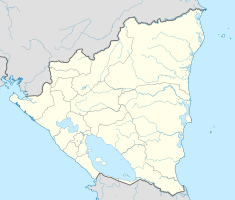Prinzapolka
| Prinzapolka | ||
|---|---|---|
|
Coordinates: 13 ° 24 ′ N , 83 ° 34 ′ W Prinzapolka on the map of Nicaragua
|
||
| Basic data | ||
| Country | Nicaragua | |
| Department | Region Autónoma de la Costa Caribe Norte | |
| Residents | 6189 (2000) | |
| Detailed data | ||
| surface | 7.020 km 2 | |
| Population density | 882 inhabitants / km 2 | |
| height | 5 m | |
| Time zone | UTC −6 | |
| Prinzapolka on the Rio Prinzapolka | ||
Prinzapolka , Principulco or Prinzapolca is a municipality in the Región Autónoma de la Costa Caribe Norte in Nicaragua , at the confluence of the 254-kilometer-long Río Prinzapolca in the Caribbean . The county seat of Prinzapolca is Alamikamba.
history
The name belonged to the sumo indigenous Prinsus , who were expelled in 1860 by Miskitos of the community of Wankluwa, who lived 53 kilometers south of the crossing over the Prinzapolka, Barra de Prinzapolka .
After the treaty on the membership of the Miskito coast , after membership of the Granada Confederation , to Nicaragua by José Santos Zelaya in 1894, today's municipality belonged to Puerto Cabezas , Bonanza and Rosita. Later the administration was only in Rosita, today the municipality is independent.
From around 1850 to 1979 the Río Prinzapolca was used as a transport route for valuable goods. These goods were: gold, silver, copper, zinc, wood and bananas that were exploited by US companies. From 1916 to 1921 the companies Fidden Minning and Tonopah used the Río Bambana and the Río Prinzapolka to transport gold to the Caribbean, where it was loaded onto ships. From 1916 to 1928, the La Luz and Los Angeles Minning Company had women of the Sumo ethnic group carry 40 kg of gold each from their mines to the Río Wani, where it was transported in dugouts to the Caribbean by 12 rowers in nine days.
In 1930 , after an agreement with the communities, the Green Star Company began growing bananas for export. In 1930 the Waddens Prinzapolka Company felled spruce from the Prinzapolka and Bambana areas. From 1930 to 1980 the Neptune Gold Minning Company exploited the area. In 1942 the Rubber Reserve Corporation began tapping natural rubber from Castilla elastica , Palo de Hule as a strategic asset for the USA. For this purpose, 13 airstrips were created, one in Alamikamba, which has developed into the main transport axis for the precious metal mines in the region. In 1947 the Nicaraguans Adán Hislop and Mónico Largaespada signed a contract with US companies for the felling of precious woods such as mahogany ( caoba ) and Cedrela tubiflora (cedro real), which was then operated for 25 years.
In 1953 mining companies built roads between Siuna, Rosita and Bonanza and a branch to Alamikamba. From 1957 to 1958 the mining companies built the port of Puerto Isabel five kilometers south of the Barra de Prinzapolka , the crossing over the Prinzapolka. This was the loading port for the ships with export and import products. The companies drove the residents off the banks of the rivers that formed the communities that exist today.
The rights of the indigenous communities as the legal owners of the areas on which they live were fought for in long battles by the Miskitos, Sumus, Mayagnas, Ramas and Garífonas. Since 1956 there is a Ley de Autonomía in which the rights of the residents are described. In 1974, the Alamikamba and Tasbapouni communities were brought before the Puerto Cabezas District Court by a US business group on charges of occupying their own land. Roberto Edward, Merrick Burlinson, Joseph Patten, Brown Keller, Richard Clarence, Twist Giltne and Paul Stauder Morales, represented by Hodgson Hodgson, sued for the evacuation of 58,888 hectares.
Individual evidence
- ↑ FICHA MUNICIPAL Prinzapolka (PDF; 164 kB) ( Memento from March 19, 2013 in the Internet Archive )

